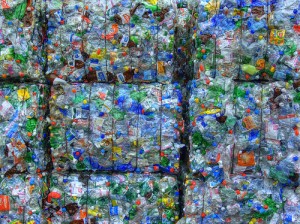
Two reports indicate that the U.S. recycling volume of polyethylene terephthalate (PET) went up in 2010, and the country’s recycling rate rose for the seventh consecutive year.
The plastic recycling industry’s annual all-bottle recycling rate report was released by the American Chemistry Council and the Association of Postconsumer Plastic Recyclers (APR). It includes data on PET and high-density polyethylene bottles and containers, which is the second most recycled plastic. Total plastic bottle recycling rate was 28.8%, up from 27.8% in 2009, and total pounds of plastic bottles collected increased by 123 million pounds for 2010 over 2009, with increases for PET, high-density polyethylene (HDPE), and polypropylene bottle resins, according to the report.
The numbers on recycling of post-consumer PET containers were presented in a report from the National Association for PET Container Resources (NAPCOR), APR, and the PET Resin Association. Mike Verespej, Washington, D.C. correspondent for Plastics News, writes:
After staying flat for two years, the volume of PET bottles recycled in the United States increased by 113 million pounds in 2010, pushing the recycling rate close to 30 percent for the first time since 1996.
The 2010 rate of 29.1 percent is up from a low of 19.6 percent in 2003, and is only 2.6 percentage points lower than the 31.7 percent rate in 1996.
Expanded bottle-deposit programs and sales that recovered to 2008 levels are responsible for the boost. NAPCOR told Verespej that although the total volume of PET bottles recycled increased from 1.444 billion pounds in 2009 to 1.557 billion pounds in 2010, almost half of the increase can be credited to expanded bottle-deposit programs in Oregon, Connecticut, and New York.
And, according to the NAPCOR report, negative growth in PET bottles and jars sold in the U.S. ended in 2010 with a rebound more robust than anticipated, and all beverage categories posted positive growth. Specifically, juice, juice drinks, and ready-to-drink tea had double-digit increases.
“Recycling our used plastics is one of the easiest ways all of us can help support our economy and the environment,” said Steve Alexander, executive director of APR in a statement. “Companies across the U.S., many of them small businesses, rely on a steady stream of recycled plastics to make useful, innovative products, such as performance fleece, low-maintenance backyard decks, kitchen gadgets, new bottles, and even auto parts.”
But the recycling industry may need to change how it does business to go further. To keep up with current and projected demand for recycled PET material, NAPCOR calculates that the PET bottle recycling rate would need to be at least 48% by 2013, according to the its report. “Up to this point,” the report stated:
[T]he primary concerns of this industry — collection, design for recycling principles, and the use of recycled content — have been addressed voluntarily and inconsistently. The question is whether that sort of approach can support the current infrastructure and allow for the growth that will be necessary to make this a sustainable industry.
Source: “Growing demand from packaging boosts US PET recycling rate,” Plastics News, 10/12/11
Source: “Post Consumer PET Container Recycling Activity,” NAPCOR report, 10/12/11
Source: “PET Container Recycling Rate up to 29% for 2010,” NAPCOR press release, 10/12/11
Source: “Plastic Recycling Rate Reports Released,” APR, 10/13/11
Image by twicepix, used under its Creative Commons license.
